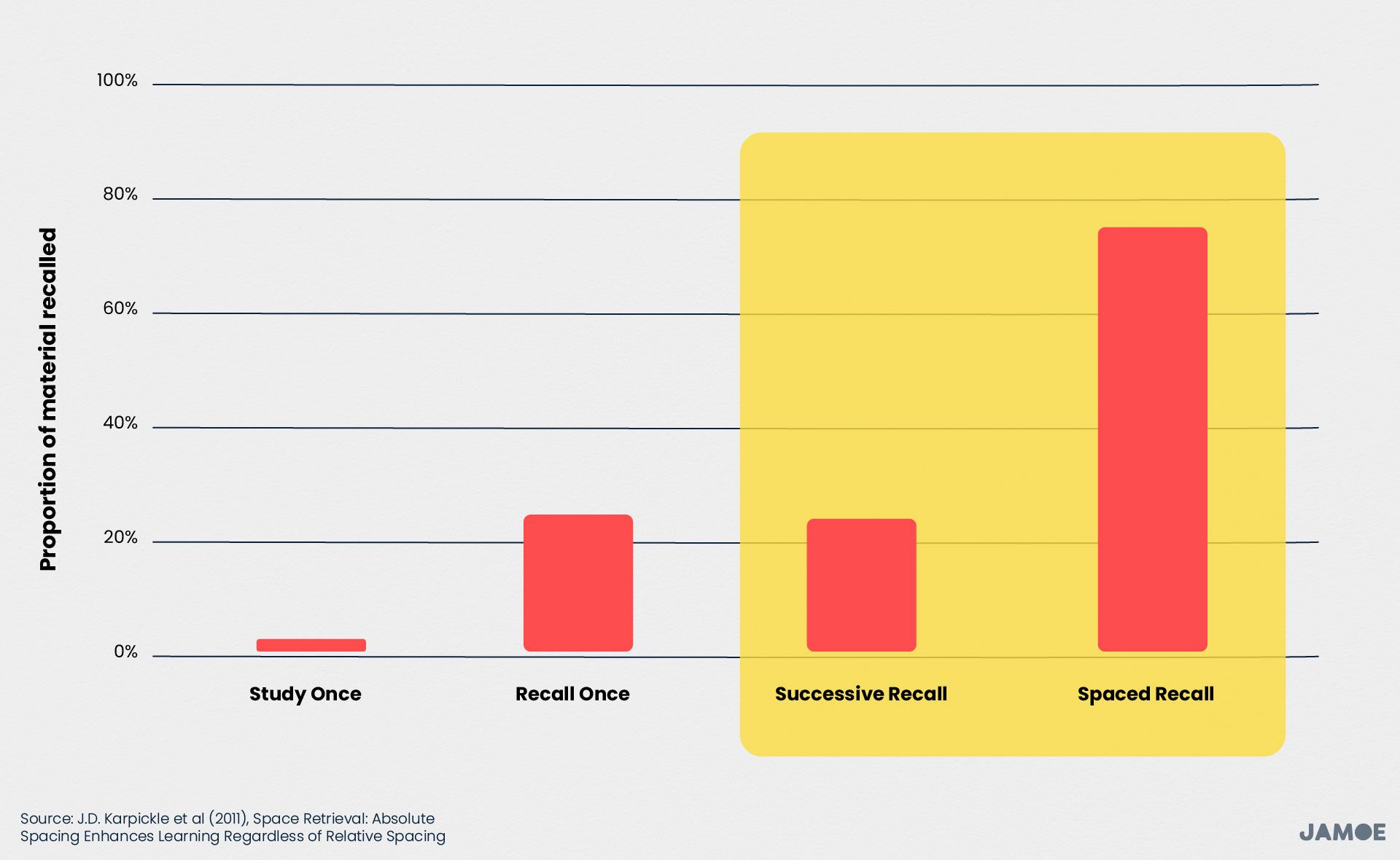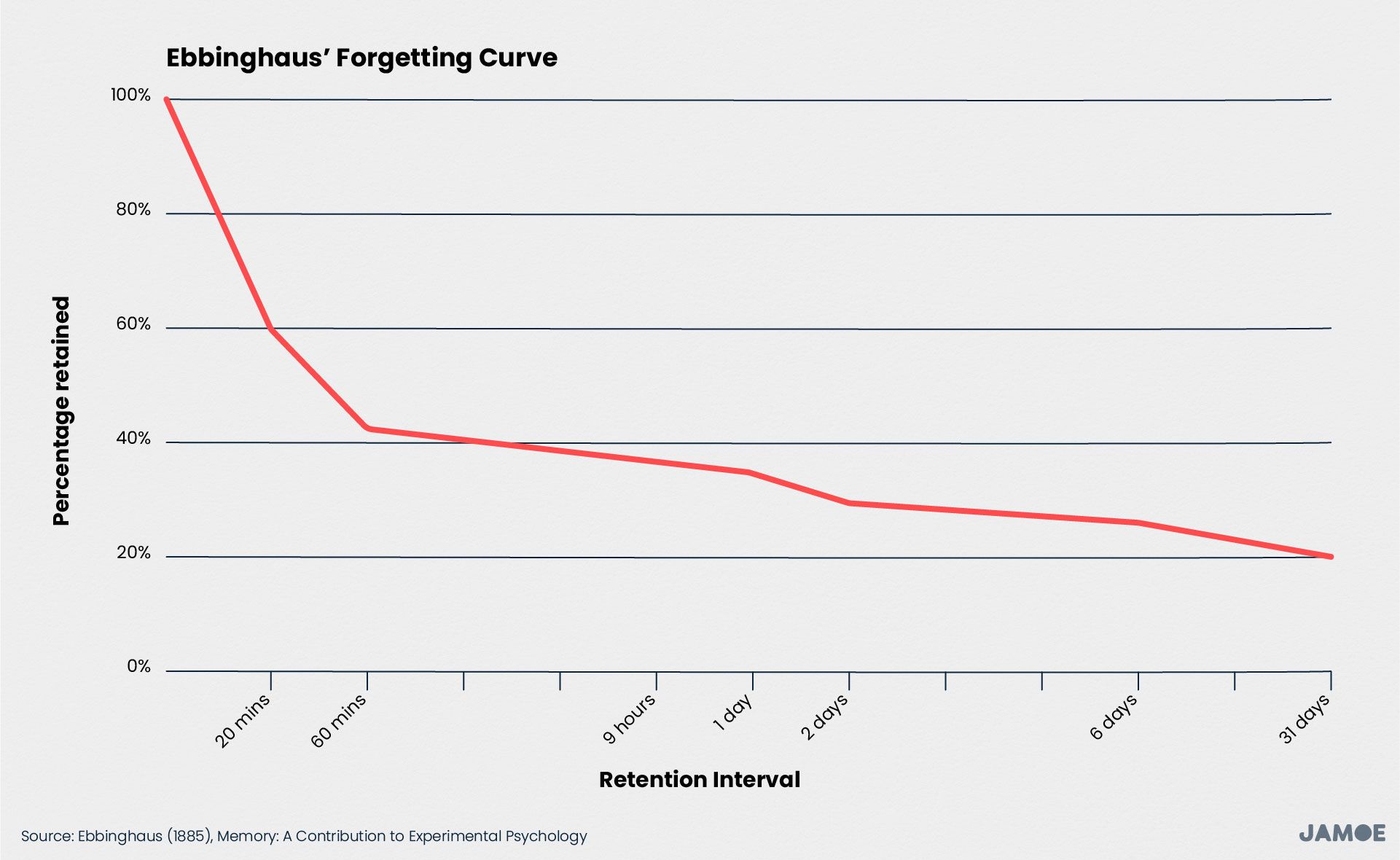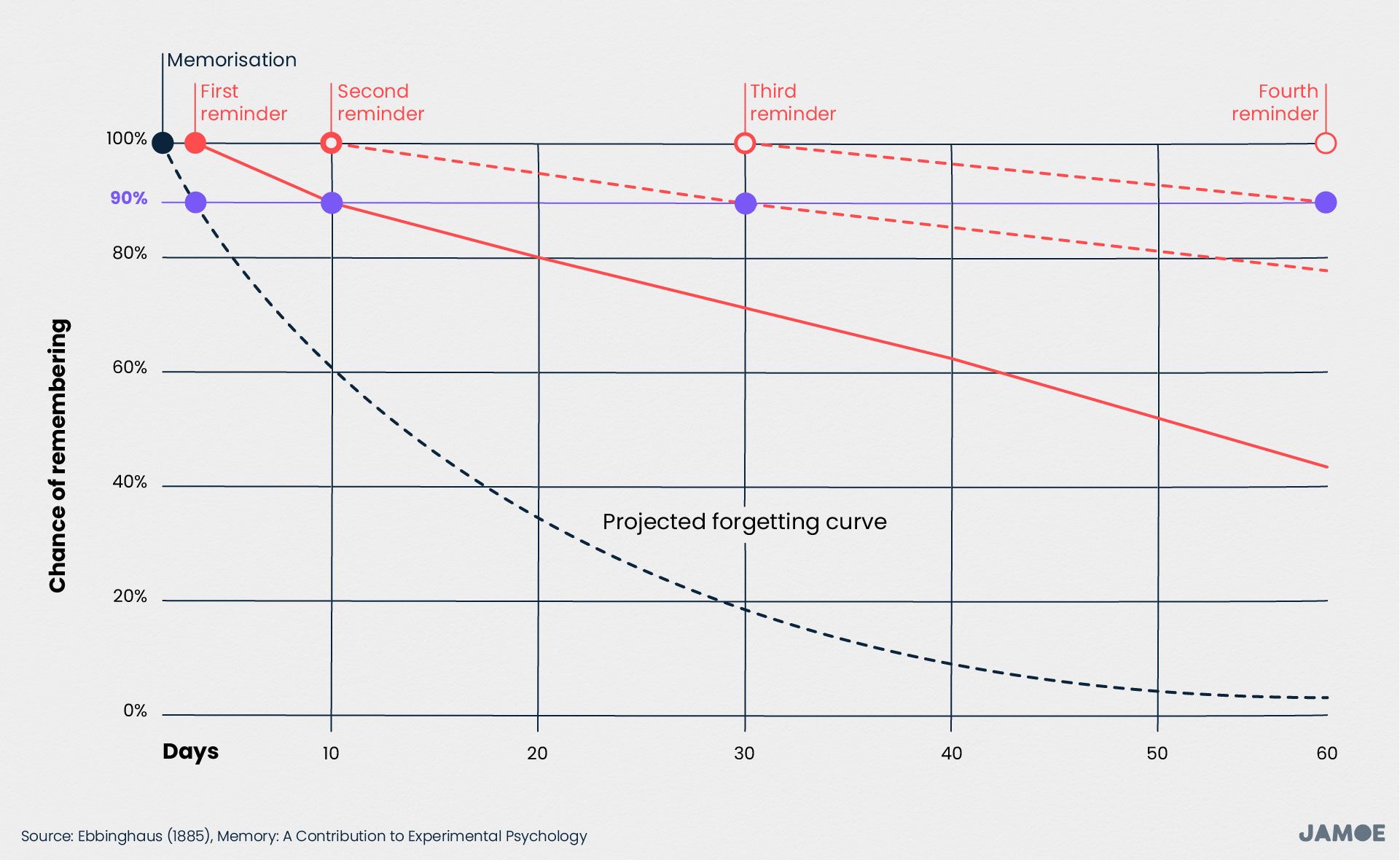A Practical Guide To Memorising Anything With Spaced Repetition
At a glance
- Based on the reader question: Can we talk about memory? I've been disheartened by the constant feeling that I have a sieve brain, and wondered how you and the team made things stick at Oxford? – Lucas, Canada
- Learn the evidence-based way to recall more, even if you spend less time overall studying, by spacing out your study sessions. You'll also learn how the mind forgets and why cramming is a waste of time.
- Use our approach of combining spaced repetition with active recall to create a simple to implement system for learning, so you can work smarter, not harder.
Introduction
The 2011 study published in the Journal of Experimental Psychology quantified the value of spaced repetition by finding that using this memorisation technique increased retention by 200%. This advantage was achieved without any additional learning time. The only difference was the technique used. That means for the same amount of effort, one set of students remembered 75% of the Swahili vocabulary they learned a week earlier, while the other group could only recall 25% of the material.
Your time is precious, so applying spaced repetition to whatever you’re learning will prevent you from wasting your time on things that will be easily forgotten. To assist, we’ve translated the research around quantitative memory into practical insights you can adopt. By blending these methods into your existing learning approach, you’ll be able to achieve more with less by working smarter, not harder.
If you’re new to the technique, your results will be especially wild.
What is Spaced Repetition and How Much of a Difference Does it Make?
Spaced Repetition vs. ‘Cramming’
Spaced repetition is the act of recalling the information you want to remember over time. A rudimentary example would be reading the capital cities of Africa, and then quizzing yourself on what they are after 5 minutes, 15 minutes and 60 minutes. You’re literally spacing out each repetition of the information you want to learn.
Underneath this technique, a debate rages: can you achieve the same results by recalling the information in three successive repetitions rather than spacing it out? That is, should you space out your learning or ‘cram’?
That was one of the questions that the 2011 ‘Spaced Retrieval’ study set out to answer with the aid of some Swahili. 96 American undergraduates at Purdue University were gathered and presented with a collection of Swahili words and their English translations (e.g. matata - trouble).
To test the different methods of memorising vocabulary, the students were divided into groups, with each group being taught the words in a different way. The researchers called this phase of the experiment the Learning Phase, as students made their way through the 100 Swahili-English vocabulary cards. The four ways the students learned the vocabulary were as follows:
- Study Once: Shown the word once
- One Recall: Shown the word once, and asked to recall it once
- Successive Recall: Shown the word once, and asked to recall it three times in a row
- Spaced Recall: Shown the word once, and asked to recall it three times at different intervals
The students were then dismissed. After one week, the students were invited back to have their ability to recall the Swahili-English vocabulary tested. The most shocking finding can be seen on the highlighted portion of the graph.

The highlighted portion of the graph shows two groups of students that spent the same amount of time studying and recalling the vocabulary, but achieved markedly different results. By simply spacing out the activity of recalling the information, the Spaced Recall group was able to outperform the Successive Recall group by 200%, and it cost them nothing extra in time.
Understanding why involves going back to the seminal work published in 1885 by the philosopher turned experimental psychologist who pioneered the study of quantitative memory research, Hermann Ebbinghaus. In his book, he shared the idea of the forgetting curve and the learning curve. Once these curves have been addressed, we’ll package up the insights from these experiments, so you can apply them to your own studies.
An Aside on Remembering People’s Names
Just before that, there is something missing from the above graph. The Study Once group’s proportion of words recalled isn’t explicitly labelled. So there isn’t any doubt, yes, they achieved a dismal score of 1%.
This group is representing those of us who can meet someone, hear their name, and then forget it with flawless consistency. The Study Once group are also representing those of us that are in education systems that teach topics once, and then don’t revisit them until the day of the exam.
These behaviours don’t appreciate our cognitive constraints, but now that you’re equipped with the knowledge of how our memories work, you’ll know to trigger a quick mental reminder that the tall fellow with freckles is called Frank a few moments after meeting. That way, you’ll boost your retention from 1 in 100 to 1 in 4.
There is power in a name, and that’s how you can remember them.
The Forgetting Curve and Learning Curve
The Forgetting Curve
Memories fade fast. Twenty-minutes after being told something, 40% of that information will be forgotten. After that, things go exponentially downhill. This decay in memory is known as the forgetting curve. This curve was born out of the experiments conducted by Ebbinghaus and has been successfully recreated by modern scientists to affirms it validity. As such, it’s very much become the darling of how psychologists think about memory.

The Learning Curve
The counter-balance to the slippery slope of forgetting is the learning curve, which elegantly shows how spaced repetition combats information decay. It also reveals something unintuitive: creating durable memories, in part, relies on us forgetting.

The learning curve shows that every time we recall a memory, we strengthen it. In practice, the memory’s health is reset, and the rate of decay is reduced, as shown by the forgetting curve (shown in red) becoming flatter. As there are fewer gaps we need to fill in, each successive attempt to recall what we’ve learned gets shorter.
It’s like having a jigsaw puzzle that resets a little closer to the completed picture each time you sit down to assemble it.
However, the most crucial component is realising what you’ve forgotten. That’s why answering questions, completing practice papers, and teaching endure as the most efficient methods for learning. Without mercy, these active recall techniques expose what we don’t know, and in so doing allow us to retrieve the missing puzzle pieces and add them back to the picture.
Understanding and applying spaced repetition is what will allow you to remember something years after learning it. It’s one of the purest examples of achieving more with less, and will allow you to be extraordinarily more efficient with your time.
Applying Spaced Repetition to your Learning
Applying spaced repetition to whatever you need to learn requires these three ingredients:
Focusing on What Memories Matter
Being productive is not doing more, but doing more of what matters. So the first thing to do when preparing for an exam is to look at an exam paper and the syllabus. Between these two things, you’ll have a clear idea of the target you’re trying to hit, that is, the questions you need to be able to answer.
Doing this is often called ‘scoping’, and it should be the first thing you do when learning a topic. However, this activity is normally relegated to near the end of the academic year, and we’re confronted with the shock of realising that we’ve been paying attention to information that isn’t going to be tested.
Once you’ve scoped your topic, you can then divide it into sub-topics, and then break these sub-topics into discrete practice questions that you can use to complete recall exercises with.
Realising What You’ve Forgotten
All recall activities should be active not passive. It’s the difference between standing in a shower and hoping the warm water will clean you, and giving yourself a good scrub.
A passive recall activity would be reading over your notes, while an active recall activity would be teaching or answering questions, whether they be of your own invention or practice exam questions. The most effective form of active recall is the Feynman Technique, which we’ve broken down here.
Creating a Spacing Schedule
Keeping track of your understanding of each topic is the final important ingredient for practicing spaced repetition. The Jamoe Retrospective Revision Timetable is the approach we recommend, as it’s been tried and test for exams such as those at the University of Oxford.
Using this will allow you to see your confidence levels across topics, prioritise your time, and know which topics you need to spend time recalling.
How Long Should a Recall Session Last?
30 minutes.
It’s long enough for you to zone into the work, but not too long for it to become tiresome. These drills can be in the form of flashcards, where there is a question on one side and the answer on the reverse. The question, and your attempt to answer it, will reveal what you’ve forgotten. You can then reaffirm your knowledge by reviewing the answer.
Conclusion
Reading this article is wonderful, and we appreciate your company. However, we’d much prefer you use this memorisation lemon to make some lemonade.
It’s for that reason we’ve avoided mentioning things that will distract you from just getting started, like systems, set ups, and software that too often plague other guides. That’s just putting the cart before the horse.
Instead find something small that you want to remember, and try applying spaced repetition to it. Getting familiar with the process, feeling its benefits, and then expanding from there is a more reliable way to ensure you can start finding a better way to solve the problems that matter.
For example, you could try our Shakespeare challenge below, or submit a question to the team if you’re looking for more advanced guidance on how to boost your memory.
Putting Spaced Repetition to the Test with Shakespeare
Try this recipe for learning the first eight lines of Shakespeare’s, ‘Romeo and Juliet’:
Two households, both alike in dignity
(In fair Verona, where we lay our scene),
From ancient grudge break to new mutiny,
Where civil blood makes civil hands unclean.
From forth the fatal loins of these two foes
A pair of star-crossed lovers take their life,
Whose misadventured piteous overthrows
Doth with their death bury their parents' strife.
Learning Instructions
Read the lines, cover the lines, and then repeat what you remember. Spend 5-10 minutes doing this.
Tip: We recommend learning the lines two at a time.
Shakespearean Spaced Repetition Schedule
Day 0: Learn the lines for 5-10 minutes
Day 1: Recall the lines, review them to correct yourself, and repeat. (5 minutes)
Day 3: Recall the lines, review them to correct yourself, and repeat. (5 minutes)
Day 7: Recall the lines, review them to correct yourself, and repeat. (5 minutes)
You’ll find that you’ll be able to recall the lines with increasing accuracy, and much faster than normal. Now you’ve completed your first successful spaced repetition, go forth and find a greater dragon to conquer.
This article is part of the Redraft newsletter, where we answer reader questions. Submit your question here or subscribe for free.
Learn faster. Think deeper. Stress less.




